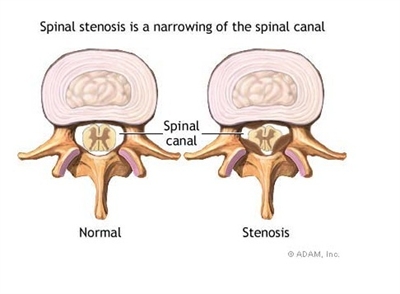Spinal Stenosis
Stenosis refers to a narrowing of an opening that is normally larger. In spinal stenosis, the normally clear opening of the spinal canal has narrowed, resulting in a channel that is too small for the spinal cord. Approximately 75% of spinal stenosis cases involve the lumbar spine and commonly affect older patients (about age 60) due to the spinal stenosisdegeneration of the spine over time.
Sciatica - cramping, tingling, weakness or numbness that radiates from the lower back to the buttocks and legs and worsens with activity
Your physician will conduct a physical exam that may require you to do a series of movements to determine where the pain is in the legs and lower back as well as to determine your strength and your ability to move. To assess nerve function, your physician may use a rubber hammer to check your reflexes.
Diagnostic imaging tests may be ordered that include: CT scan of the spine, EMG, MRI of the spine, and/or X-rays.
In a posterior cervical foraminotomy, your physician will, from the back of the neck, relieve the pressure on the spinal nerves by cutting or shaving away parts of the open to open the nerve root opening (foramen) in the lumbar area, where the spinal nerves branch out to the lower extremities.
Laminectomy
A laminectomy removes the lamina, two small bones that make up a vertebra. This is another procedure that is used to relieve pressure placed on the spinal nerves. By removing the bones, more space is created in the spinal column, giving the nerves more room.
Spinal fusion
A spinal fusion may be performed after a foraminotomy or a laminectomy to further stability. This surgery will fuse together two vertebral bones together, one on top of another, so that there is no longer any movement between them. This fusion can be done with screws, plates, or cages. Depending on your individual medical history and current health status, our spine specialists may recommend an artificial disc replacement instead of a spinal fusion.
Inflammatory Disease
Rheumatoid arthritis, a condition where joints in the upper neck may be destroyed causing severe stiffness and pain.
Injury
Fall
Spondylolysis (click here to read more about this condition)
Sports Injury
Whiplash
Abnormal sensations, such as prickling or burning
Dizziness
Headache
Neck pain
Neck stiffness
Shoulder or upper back pain
Immediate medical care should be sought when an injury causes neck pain that shoots down the arms and legs.
Pain or numbness that present in the arms and legs without serious neck pain.
If there has not been an injury and you experience neck pain that is:
Severe
Consistent and persistent over a period of time
Accompanied by pain in the arms and legs
Accompanied by headaches, dizziness, tingling, or weakness in the legs
A hard fall
Car accident that involves whiplash
Contact sports injuries
Headache in the back of the head
Muscle spasms and pain in upper shoulders
Neck stiffness or decreased range of motion (sideways, up and down, circular)
Numbness, tingling, or weakness in arm or hand
Pain in the back of the neck that worsens with movement
Pain that gets worse a day or so after the injury, not immediately
Sore Throat
Bone diseases
Genetic or congenital problems can influence the development of the spinal cord
Obesity
Poor dietary habits
Poor posture and body mechanics
Physical abuse
Smoking
Foraminotomy

